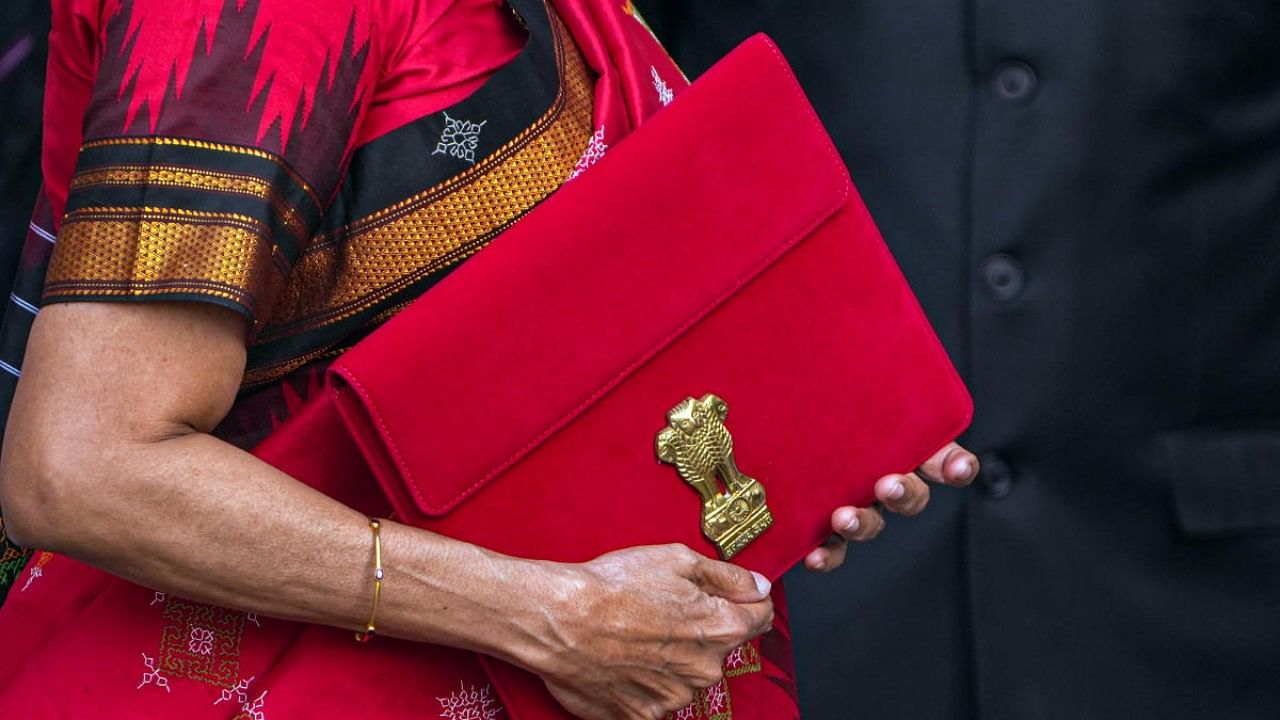
Union Finance Minister Nirmala carrying a folder-case poses for photographs outside the Finance Ministry at North Block, in New Delhi.
Credit: PTI File Photo
The 2023 Union Budget was termed the first budget in 'Amrit Kaal'. In order to promote macroeconomic stability, infrastructure, green growth, technology, and job creation, the Union Budget 2023–24 placed a strong emphasis on these areas while also providing citizens, particularly young people, with plenty of tax opportunities.
Here are the biggest highlights of the 2023 Union Budget:
Revisions to direct tax regime
Last year's budget introduced several modifications to income tax slabs under the new tax regime—most notably, the revisions enabled those opting for the new tax regime to be exempted from paying income taxes on annual earnings of up to Rs 7 lakh.
Surcharge relief for HNIs
When income exceeded Rs 5 crore, High Net Worth Individuals (HNIs) were earlier subject to an additional 37 per cent income tax surcharge. In last year's budget, the surcharge was lowered to 25 per cent in accordance with the new tax regime, which will result in a decrease in the effective tax rate from 42.74 per cent to 39 per cent.
Development of infrastructure
Capex increased significantly to Rs 10 lakh crore, which was 33 per cent higher than the budget estimate of Rs 7.5 lakh crore for 2022-23.
The government set aside Rs 1.10 lakh crore for infrastructure development, which included road, rail, airport, port, and highway construction.
The Finance Minister made the point that investments in productive capacity and infrastructure have a significant multiplier effect on employment and growth, which will aid in boosting the economy and generating job opportunities.
Further, proposals to set up new hospitals and medical schools to boost national healthcare were included in the budget.
On the urban development front, the budget had earmarked Rs 10,000 crore annually for infra development.
Allocation for the PM Awas Yojana, aimed at providing affordable housing, also received a considerable boost last year.
Propositions to revive over 50 airports, helipads, water aerodromes, and advanced landing grounds were also included in the budget in a bid to boost regional air connectivity.
Agriculture and rural economy boost
The Union Budget aimed at building a digital public infrastructure, that is, building an accessible, inclusive and informative solution for farmers.
Creating an agriculture accelerator fund which would further encourage innovative start-ups in the rural areas.
'Atmanirbhar Bharat' horticulture clean plant program was launched to boost the production of high-value horticulture crops.
Rs 20 lakh cr agricultural credit targeted at animal husbandry, diaries and fisheries.
'Shree Anna' scheme was launched, which enabled India to become the global hub for millets.
Setting up of widely available storage capacity enhancing farmers' remuneration by enabling sale at appropriate times.
Healthcare gets a boost
The healthcare sector boost included plans to set up 157 new nursing colleges, the launching of a sickle cell anaemia elimination mission, new programs to promote the scope of research in the pharmaceutical industry, and ICMR labs to encourage Joint Public and Private Medical research.
Educational improvements
Talking about education advancements, teachers' training was intended to be revamped via Direct Institutes of Education and Training, setting up of National Digital Library for children and adolescents, and encouraging states to set up physical libraries at Panchayat and ward levels.
Empowering Women in the society
The finance minister had claimed that the central government saw an opportunity to transform society and realize their vision of growth in areas like creating jobs, opening up economic opportunities, and bolstering macroeconomic stability.
Women were given access to a brand-new one-time small savings program. The program is called Mahila Samman Saving Certificate, and it will be accessible until March 2025. It offers a fixed interest rate of 7.5 per cent along with the possibility of a partial withdrawal.
For a maximum of two years, a deposit of up to Rs 2 lakhs may be made under this scheme in the name of a woman or a girl child.
‘Green Growth’ strategy
A growth strategy for the economy known as "green growth" places an emphasis on sustainable development and lessens its negative effects on the environment.
The Union Budget placed emphasis on green fuel, green farming, green mobility, green buildings, and green equipment. The budget included proposed measures to promote energy efficiency in a number of economic sectors.